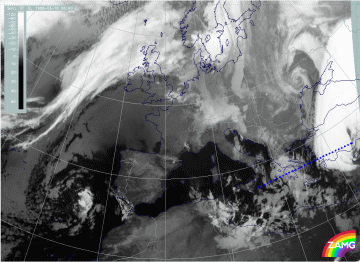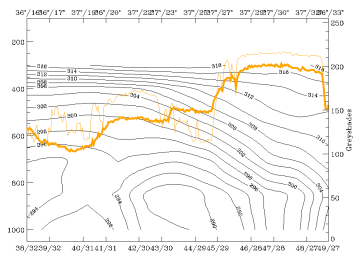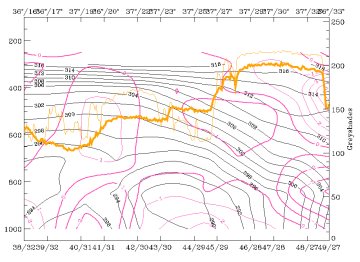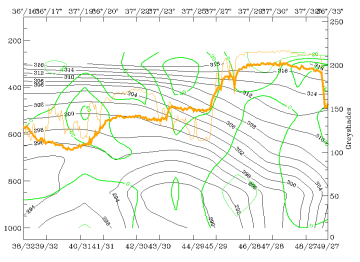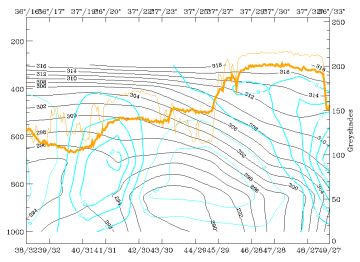03.00 - 06.00 UTC - Comma Diagnosis - Use of vertical cross sections
|
16 March 1998/06.00 UTC - Meteosat IR image; position of vertical cross section indicated
|
|
Some additional hints can also be derived from the use of vertical cross sections. The vertical cross section line is perpendicular to the Comma and to the rest of the frontal cloud band over Turkey.
|
16 March 1998/00.00 UTC - Vertical cross section; black: isentropes (ThetaE), orange thin: IR pixel values, orange thick: WV pixel
values
|
|
As can be seen in the image above, the broad peak of high values between 37N/26E and 37N/32E corresponds to the white frontal cloud band, while the secondary peak between approximately 36N/20E and 37N/22E represents the Comma. The WV signal is low in the Comma area indicating dry air above, although the driest air connected with the Black Stripe can be found at the rear of the Comma.
|
16 March 1998/06.00 UTC - Vertical cross section; black: isentropes (ThetaE), magenta thin: divergence, magenta thick: convergence,
orange thin: IR pixel values, orange thick: WV pixel values
|
16 March 1998/06.00 UTC - Vertical cross section; black: isentropes (ThetaE), green thick: vorticity advection - PVA, green thin:
vorticity advection - NVA, orange thin: IR pixel values, orange thick: WV pixel values
|
|
16 March 1998/06.00 UTC - Vertical cross section; black: isentropes (ThetaE), cyan thick: vertical motion (omega) - upward motion, cyan
thin: vertical motion (omega) - downward motion, orange thin: IR pixel values, orange thick: WV pixel values
|
|
Very striking is the increase of upward motion (left image bottom) compared to the time before (compare 15/21.00 - 16/00.00 UTC - Frontal Diagnosis - Use of vertical cross sections). Both convergence in low (left image top) and PVA in upper levels (right image top) work together and lead to a well developed maximum of upward motion. This is the reason that the Comma structure is maintained throughout the day, intensifying and becoming a more distinct spiral structure later on.
Summarizing, one can say that the development of the Comma is rather untypical. It happened in the cold air behind a Cold Front but below the cloud shield of an approaching frontal zone from the south. Only after this frontal system propagated eastward did the Comma cloudiness become visible. But even then a sinking dry relative stream restricted the growth of the Comma clouds. Nevertheless the physical environment for a Comma was fulfilled quite well and hence the cloud feature was rather long-lived and intensifying later on.
